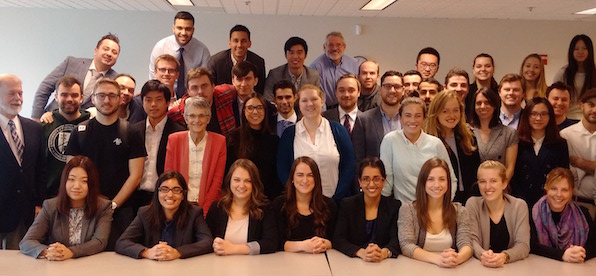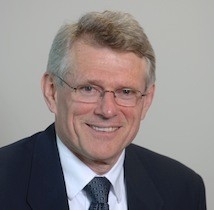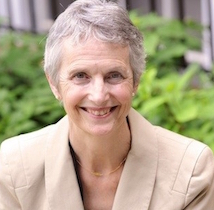News
» Go to news mainUnstructured simulation brings the fast pace of business to MBA's
 “You are playing the role of Yahoo’s Board,” reads a note directed to a group of first-year Corporate Residency MBA students. “It has obviously been an eventful week with the change in the Alibaba strategy, losing yet another key executive just this morning, and with all of the rumours circulating…” The note is short, a simple description of the situation in which the students—now Yahoo Board members—find themselves. It ends, “Your breakout room is 5053.”
“You are playing the role of Yahoo’s Board,” reads a note directed to a group of first-year Corporate Residency MBA students. “It has obviously been an eventful week with the change in the Alibaba strategy, losing yet another key executive just this morning, and with all of the rumours circulating…” The note is short, a simple description of the situation in which the students—now Yahoo Board members—find themselves. It ends, “Your breakout room is 5053.”
The note was the only direction this group of students received during an activity that took place one busy weekend in December. Seven other student groups received notes informing them of their roles as consulting groups and senior personnel in Verizon. The MBA students had to act quickly on the information they were given.
 Dr. Rick Nason, a finance professor in the Rowe School of Business, began running this event, which he calls “unstructured simulation,” in 2009, the first year of the CRMBA program. Each year students participate enthusiastically despite the fact that is an extracurricular activity with no credit attached that takes place just before exams, a very busy time of year for students. “It’s a bit hard to explain what it is,” says Nason, “because it’s intentionally so loose and unstructured.” Each year he bases the simulation on a real-time, real-world situation in business. The students form groups and are randomly given a role. This year, most groups were consulting firms vying for contracts with the Yahoo and Verizon groups. The few details given in that one short note were true, meaning that they mirrored the actual situation faced by Yahoo in December: the loss of a key executive, the possibility of being acquired by another company, and the maternity leave at a tense time of the president and CEO.
Dr. Rick Nason, a finance professor in the Rowe School of Business, began running this event, which he calls “unstructured simulation,” in 2009, the first year of the CRMBA program. Each year students participate enthusiastically despite the fact that is an extracurricular activity with no credit attached that takes place just before exams, a very busy time of year for students. “It’s a bit hard to explain what it is,” says Nason, “because it’s intentionally so loose and unstructured.” Each year he bases the simulation on a real-time, real-world situation in business. The students form groups and are randomly given a role. This year, most groups were consulting firms vying for contracts with the Yahoo and Verizon groups. The few details given in that one short note were true, meaning that they mirrored the actual situation faced by Yahoo in December: the loss of a key executive, the possibility of being acquired by another company, and the maternity leave at a tense time of the president and CEO.
 “The key point is that there is no structure,” says Nason. “The situation literally evolves over the period of the exercise. I have no idea myself how it’s going to play out.” In this case, students in the consulting groups quickly began creating pitches, hoping to be engaged as advisors to the Yahoo group. Dr. David Stuewe, a faculty member who helped run the simulation, explains a bit of the process: “Major merger acquisitions are about how you come up with the money to buy something and what you do with what’s left over in the company. You pitch the acquisition and sell it in the marketplace. So the students, over the day and a half of this simulation, were doing these analyses and going to the companies and making these pitches.” Stuewe recounts the actions of a particularly enterprising group: “I was walking into the building and a bunch of students surrounded me and said ‘we want to retain you as our advisor. You have to sign this document saying you’re not going to help anyone else.’ It’s real-time, it’s real acquisitions. That’s the stuff they’re dealing with.”
“The key point is that there is no structure,” says Nason. “The situation literally evolves over the period of the exercise. I have no idea myself how it’s going to play out.” In this case, students in the consulting groups quickly began creating pitches, hoping to be engaged as advisors to the Yahoo group. Dr. David Stuewe, a faculty member who helped run the simulation, explains a bit of the process: “Major merger acquisitions are about how you come up with the money to buy something and what you do with what’s left over in the company. You pitch the acquisition and sell it in the marketplace. So the students, over the day and a half of this simulation, were doing these analyses and going to the companies and making these pitches.” Stuewe recounts the actions of a particularly enterprising group: “I was walking into the building and a bunch of students surrounded me and said ‘we want to retain you as our advisor. You have to sign this document saying you’re not going to help anyone else.’ It’s real-time, it’s real acquisitions. That’s the stuff they’re dealing with.”
 This year also held a special surprise: Dalhousie Provost and Vice-President, Academic Carolyn Watters made a cameo appearance as David Filo, co-founder and a major shareholder of Yahoo. “She presented to the board of Yahoo that she (David Filo) was resigning and initiating a hostile takeover of the company,” says Nason. “This of course threw a monkey wrench into everything and the students had to scramble to account for this unforeseen event.” Watters was impressed with how the students dealt with her unexpected appearance. “They were in character, reacting to shifting conditions in a complex and high-value situation with an incredible intensity that was infectious,” she says. “I was only there for an hour and then spent the rest of the weekend combing through my web sources to get more information about Yahoo’s situation.”
This year also held a special surprise: Dalhousie Provost and Vice-President, Academic Carolyn Watters made a cameo appearance as David Filo, co-founder and a major shareholder of Yahoo. “She presented to the board of Yahoo that she (David Filo) was resigning and initiating a hostile takeover of the company,” says Nason. “This of course threw a monkey wrench into everything and the students had to scramble to account for this unforeseen event.” Watters was impressed with how the students dealt with her unexpected appearance. “They were in character, reacting to shifting conditions in a complex and high-value situation with an incredible intensity that was infectious,” she says. “I was only there for an hour and then spent the rest of the weekend combing through my web sources to get more information about Yahoo’s situation.”
While the simulation may give Dalhousie’s Provost a new career path—Stuewe says that Watters “could get an Oscar” for her role as Filo—it is even more important to the careers of the CRMBA students who participate. As Nason points out, “It is an outrageously effective way to teach business students the difference between text book knowledge and real-world knowledge.”
Through this simulation, he says, students learn valuable skills such as how to lead effectively, how to handle volatility, ambiguity and unforeseen circumstances, and “how to manage themselves and others in a tense competitive environment.” Nason and his colleagues are now using this experiential learning methodology in research on the effectiveness of business schools. Watters agrees with him: “Really, why can’t every student have learning experiences like this, where data is messy and decisions are in real-time?” she says. “Gaining confidence in coping under these conditions is something every student, no matter the discipline, can use.”
The students themselves certainly recognize the effectiveness of this simulation as they move into their work lives—after a gruelling day and a half of work, they were exhausted but happy with the simulation. Says Nason, “Many alumni tell me that it was the highlight of their CRMBA.”
Recent News
- Professor M. Ali Ülkü receives 2024 Archibald Award
- Project to address harmful language relating to Indigenous peoples receives prestigious Mellon Award
- Four decades of friendly hellos
- Students speak with passion about recipients of Teaching Excellence Award
- Brothers, and Dal alums, adapt and learn to achieve career success
- Najah Attig and Oumar Sy win prestigious Graham and Dodd Scroll Award
- Curiosity in human behaviour leads Huiyan Liu (MSc’23 ) to a PhD
- In Memoriam – Dr. James R. Barker
